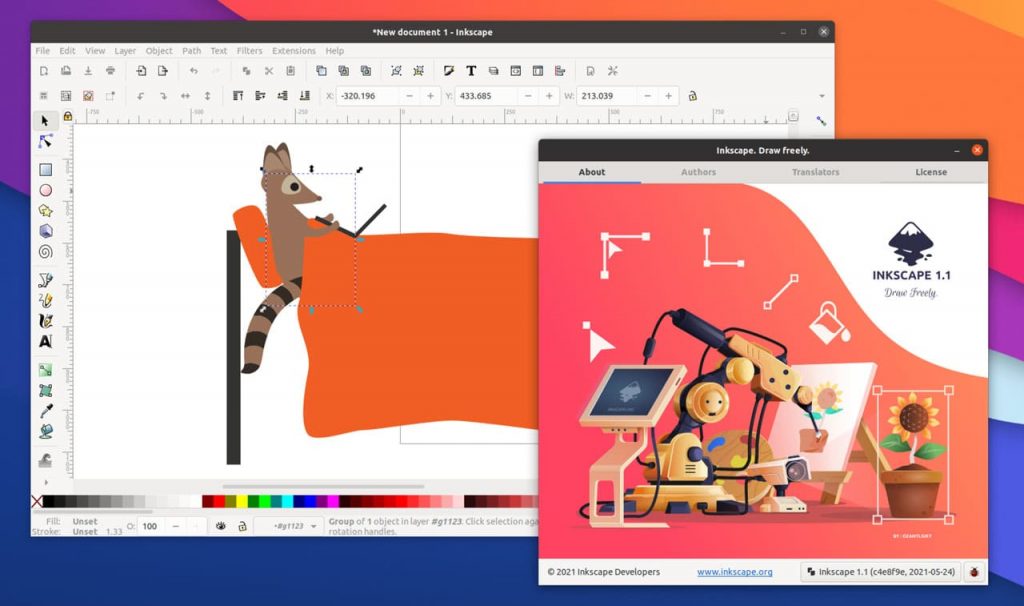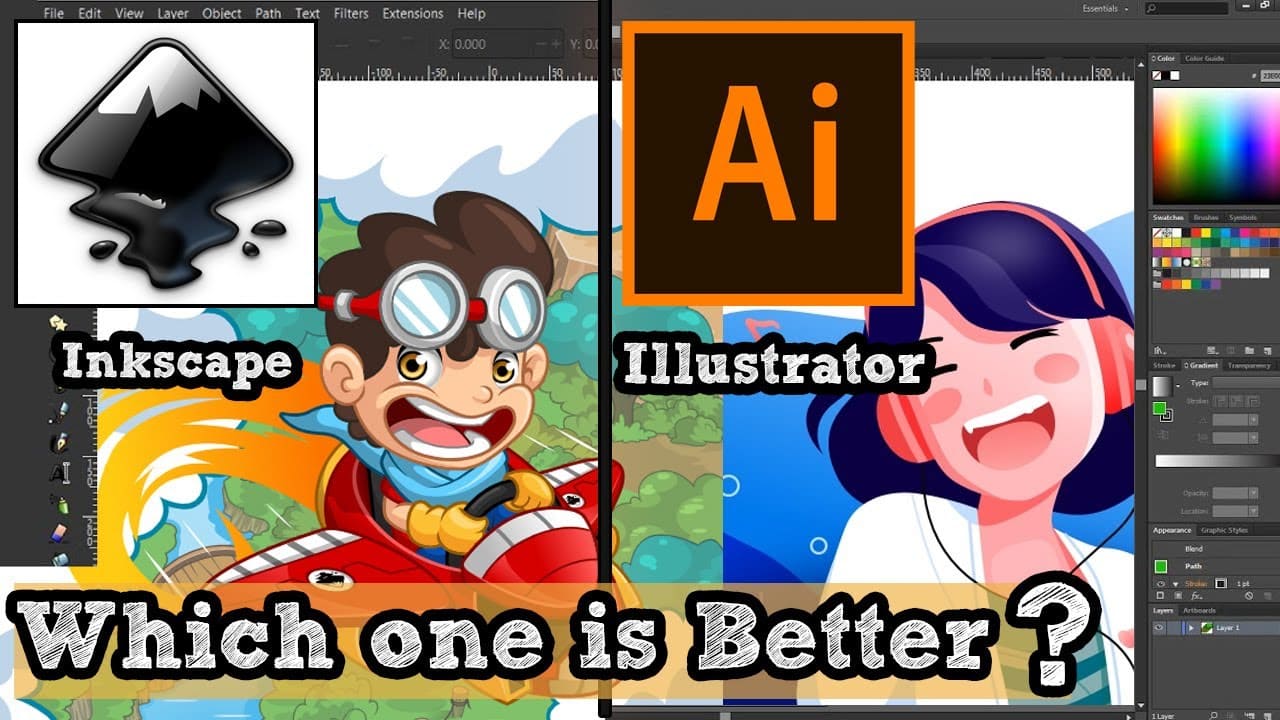Hello everyone and welcome to this new video, today, we have a controversial comparison for you that is more than just “free versus paid”, as you might think.
Since the market of computer graphics software is obviously full of options, it’s making it rather confusing when it comes to picking up which tool is right for you.
So, in this video, we will present to you a complete comparison between the most popular vector graphics software: Inkscape VS Adobe Illustrator, in which you have a high chance of coming across at least once in your lives.
Hoping this will help you settle down on one of them and hopefully clear up the confusion.
1. Inkscape Overview

Let’s start with a brief overview of Inkscape, which is a free and open-source vector graphics software that allows you to create various forms of vector art: ranging from logos, illustrations, icons and so on.
You can run it on many of the main operating systems like Windows, Mac, and Linux. Since it deals mainly with SVGs as a default format, you can expect some high-quality graphics using this tool.
Inkscape is very popular, especially, since it doesn’t require any financial investment, not to mention that it’s very suitable for beginners. Nevertheless, it doesn’t mean that it’s dedicated to amateurs only: it’s actually quite famous among professionals and veteran artists as well.
The top features that you’ll certainly like include the rich and various export options, such as EPS, PNG, PDF, SVG and more. One tangible proof of how good Inkscape is will definitely be obvious in the huge community of active users, besides the regular updates and constant improvements that will make you always satisfied with your overall experience with the software.
2. Adobe Illustrator Overview

Now, looking at the other side of the comparison, Illustrator is also a vector graphics software from Adobe’s Creative Cloud, and you can run it on the two flagship operating systems: Windows and MacOS. It allows you to create almost anything from logos, charts, drawings to icons and illustrations.
Its quite a professional program while also being very decent for beginners and newbie graphic designers. It has pretty much the same interface that you have been familiar with using the rest of the Adobe Suite.
Although the massive number of tools can be a little overwhelming at first, the User Interface will quickly get you into the mood, since it’s rather intuitive with a nice learning curve.
The main perk of vector technology is that you can scale and resize your design without even worrying about any quality loss. You can easily fit your favourite methods of art creation into the perspective illustrator: if you would like some warm-up and brainstorming, you can sketch on paper first then import the scans into your workspace rather than starting from scratch.
You can also choose to import redesigned graphics to test the waters and pick up the basics, or simply create something quickly as if you’re doing a photo collage.
Unlike Inkscape however, Illustrator is not free: you can get access to it with the Creative Cloud subscription plan, or as a singlesoftware.
3. Industries that adopted the software
As for where exactly these tools can come in handy, many designers around the world started to actively use either one or both of Inkscape and Illustrator. Being both intended for vector graphics as the main purpose, you can describe them as multi-propose programs used for various production ends.
You can spot a few cases where one of them can be better than the other. For example, Inkscape works perfectly with small size projects. So if your project requires speed and simplicity over sophistication, then Inkscape is better for you.
While when it comes to working with graphics that include typography, Illustrator can be much better. It has an awesome pack of text features that you can extend even more by integrating Adobe Fonts. Furthermore, one thing that Inkscape has over Illustrator is the ability to create and edit SVGs directly from their source code.
4. Interface & Learning Curve

When it comes to the learning curve, both Inkscape and Illustrator can somewhat be described as beginner-friendly: both having an intuitive interface that will make you feel at home. Not to mention that it’s highly customizable: because you can rearrange panels and tabs the way you like.
The tools have also quick access and keyboard shortcuts to make them even more accessible. The only thing that might result in kind of a steep learning curve at the beginning is the huge number of tools and features, which can be a little overwhelming at first.
But, the web is overloaded with various types of learning material and resources to help you get through it, and a very supportive community of creative users that share the same passion with you.
Taking a closer look at the UI, Inkscape comes with a less crowded interfacedespite being fully packed with awesome features.Which makes it simpler and a lot more effective with less distractions.

On the other hand, Illustrator is known to be an industry-standard software for graphic design. Although it’s intuitive as well, the tooling is a bit more crowded. However, this overwhelming nature can be easily decluttered, since you can control all the panels and create your own comfy workspace.
5. Workflow
Speaking of which, the interface plays a major role in making the workflow smooth and quick-paced or making it clunky and complicated. Both software is highly flexible and easy to follow, but with some nuances.
Inkscape has a smoother workflow thanks to its decluttered UI. It’s even an ideal tool for low-performance devices: meaning that it will provide you with a fluid process even if you have a low-end device with limited RAM and GPU.
When it comes to Illustrator, on the other hand, it’s heavily loaded with various functionalities that may cause the workflow to slow down a little. So again, if you have a low-performance device, that will make you consume a lot of everything: RAM, CPU, GPU and definitely some brain cells.
With the rising potential of each new update of Illustrator, the workflow will eventually get slower. If you want to use it or if you have it already, by all means, make sure that you have a powerful device with the necessary system requirements that will keep up with the advanced toolset.
6. Tools & Features

Now let’s take a look at some of the tools and features that stand out in each software. As we mentioned before, the two programs are vector-based, so you can expect unique and amazing drawing tools.
Illustrator provides you with a rich toolset, making it perfect for sketching and drawing. It has brushes for painting, shapes, pen tools, path tools and more. The tooling is also very versatile: it allows you to draw using a graphic tablet very effectively, giving you a realistic and natural experience that will make you think of classic paper drawing.
On the other hand, Inkscape offers you the same variety of tools: starting from the most basic pencil with freehand drawing options and arriving at more advanced ones like Boolean operations, bitmap tracing and colour painting over projects. It allows you to create curves and straight lines, giving you the possibility to tweak different parameters on your strokes.
When it comes to colouring, the system supports many colour modes with awesome swatches and palettes. There’s also this amazing process of creating gradients that is a lot more intuitive than the one featured in Illustrator.

Looking at things from Illustrator’s angle now, it has even more tools to push your art and inspiration even further. It offers a range of templates to start with, dedicated especially for beginners to help them get familiar with the concept at first approach.
One of the coolest tools in Illustrator is the “artboard” feature that allows you to create many artboards at the same time, helping you work on various projects within the same workspace. For example, you can work on the recto and the flipside of a business card, same time same place. Other handy tools are grids that provide you with a lot more precision when it comes to distance and perspective.
While Inkscape is still improving its features, Illustrator has gone ahead with most of them. For example, Typography tools in Illustrator are much more advanced than Inkscape: it gives you full control over the text and its properties, allowing you to tweak parameters like width, height, colour, weight, style and more.
There’s also the game-changing cloud save mode, so you can save and access your projects from any device through an internet connection.
As a final thought, Inkscape and Illustrator are fully complementary with one another, both having mobile versions as well: XInkPlus and Illustrator Draw.
7. Pricing
Arriving at the final and probably the decisive difference between them for many of you, let’s talk about price. As we mentioned before, and you’re very likely to be aware of it, Inkscape is totally free and open-source: you can download it from the official website no questions asked, and you can even contribute to further developing its potential.
When it comes to Illustrator, on the other hand, you can purchase it as part of the Adobe Creative Cloud for around $53 per month. You can also choose to have access to Illustrator only, for around $21 per month. There is a one-month free trial if you like, but if you’re just starting, Inkscape is a lot more suitable for you since it won’t cost you anything and it can perform nearly just as good.
So to conclude this comparison, both of these tools are versatile and could potentially unleash your creative mindset.
After all, the most important piece here is you, your passion and your skills. In other words, your choice will be mainly guided by whether you would invest financial resources or not.
It would also depend on your needs as a graphic artist: either looking for industry-standard software as a crucial requirement for your art or looking for a powerful tool regardless of its value from the standpoint of the market.






























